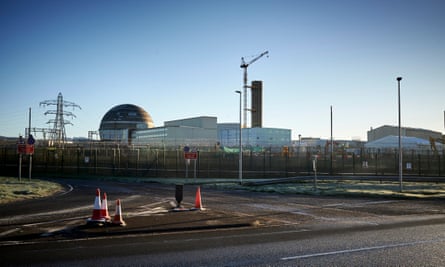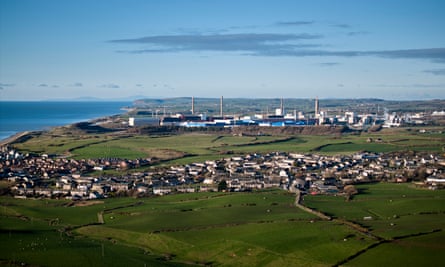"Sellafield, Europe’s most hazardous nuclear site, has a worsening leak from a huge silo of radioactive waste that could pose a risk to the public, the Guardian can reveal.
Concerns over safety at the crumbling building, as well as cracks in a reservoir of toxic sludge known as B30, have caused diplomatic tensions with countries including the US, Norway and Ireland, which fear Sellafield has failed to get a grip of the problems.
The leak of radioactive liquid from one of the “highest nuclear hazards in the UK” – a decaying building at the vast Cumbrian site known as the Magnox swarf storage Silo (MSSS) – is likely to continue to 2050. That could have “potentially significant consequences” if it gathers pace, risking contaminating groundwater, according to an official document.
Cracks have also developed in the concrete and asphalt skin covering the huge pond containing decades of nuclear sludge, part of a catalogue of safety problems at the site.
These concerns have emerged in Nuclear Leaks, a year-long Guardian investigation into problems spanning cyber hacking, radioactive contamination and toxic workplace culture at the vast nuclear dump.
Sellafield, a sprawling 6 sq km (2 sq mile) site on the Cumbrian coast employing 11,000 people, stores and treats nuclear waste from weapons programmes and nuclear power generation, and is the largest such facility in Europe.
A document sent to members of the Sellafield board in November 2022 and seen by the Guardian raised widespread concerns about a degradation of safety across the site, warning of the “cumulative risk” from failings ranging from nuclear safety to asbestos and fire standards.
A scientist on an expert panel that advises the UK government on the health impact of radiation told the Guardian that the risks posed by the leak and other chemical leaks at Sellafield have been “shoved firmly under the rug”.
A fire in 1957 at Windscale, as the site was formerly known, was the UK’s worst nuclear accident to date. An EU report in 2001 warned an accident at Sellafield could be worse than Chornobyl, the site of the 1986 disaster in Ukraine that exposed five million Europeans to radiation. Sellafield contains significantly more radioactive material than Chornobyl.
The report said events that could trigger an atmospheric release of radioactive waste at the plant included explosions and air crashes.
Such is the concern about its safety standards that US officials have warned of its creaking infrastructure in diplomatic cables seen by the Guardian. Among their concerns are leaks from cracks in concrete at toxic ponds and a lack of transparency from the UK authorities about issues at the site. The UK and the US have a decades-long relationship on nuclear technology.
Concerns about how Sellafield is run have also led to tensions with the Irish and Norwegian governments.
Norwegian officials are concerned that an accident at the site could lead to a plume of radioactive particles being carried by prevailing south-westerly winds across the North Sea, with potentially devastating consequences for Norway’s food production and wildlife. A senior Norwegian diplomat told the Guardian that they believed Oslo should offer to help fund the site so that it can be run more safely, rather than “run something so dangerous on a shoestring budget and without transparency”.
The Irish government tried to take action against Sellafield by referring it to a UN tribunal in 2006 over concerns about the site’s impact on the environment.
Scientists are trying to estimate the risk to the public from the leak from the MSSS through “ongoing radiological dose assessments”, using statistical modelling.
Sellafield is trying to extract decades of nuclear waste from MSSS, a facility dating back to the 1960s and described as “one of the highest-hazard nuclear facilities in the UK”, a task that it says could take at least 20 years. It has been leaking for more than three years.
A report in June from the Office for Nuclear Regulation (ONR) said while the current risk from the leak is deemed by Sellafield to be “as low as reasonably practicable”, scientists are increasingly concerned that the full scale of the leak, and the rate at which it may pollute the groundwater, is unclear. Sellafield is understood to argue that the leak poses “no additional risk” to staff and the public.
In 2019, Sellafield reported a leak from the storage unit to the ONR. The leak significantly worsened over the next two years, and a previously unreported document reveals that 2.3-2.5 cubic metres of radioactive “liquor” has been leaking from the facility every day. This liquid is a soup of radioactive magnesium alloy filings dissolved into water, from waste cladding that encased spent Magnox nuclear fuel.
The health implications of radiation exposure vary depending on the dosage, but can include nausea and vomiting, and long-term effects such as cardiovascular disease, cataracts, cancer to those who experience high levels of radiation. High doses can be lethal.
Inspectors said that it is not possible to work out how many cracks have formed in the silo so are using guesswork and modelling based on leaks from the facility to work out the risk posed to the public and workers at the site.
A committee of scientists, tasked with monitoring Sellafield and other nuclear sites, has warned that the silo needs much closer attention.
In July last year, the Committee on Medical Aspects of Radiation in the Environment noted in its public minutes that “the leak has been continuing at the same rate since October 2020, around 2.5m [cubic meters] per day …”.
However, the extent of the radioactive material lost to the ground from the leak was redacted from the meeting minutes.

Sellafield has faced allegations of cover-ups over safety problems. Photograph: David Levene/The Guardian
A scientist on the committee told the Guardian: “It’s hard to know if transparency is put aside because no one’s brave enough to say ‘we simply don’t know how dangerous this is – other than certainly dangerous’.
“That’s incredibly serious in the context of a site full of horrors and the legacy of experiments no one properly documented.”
Sources have warned that the site’s basic safety requirements are increasingly wearing thin, and long-term dangers are being ignored or uncontained.
“They can’t handle fire or asbestos on site, let alone the crumbling of nuclear containment materials,” one senior Sellafield employee told the Guardian.
There are also grave concerns about B30, a pond containing nuclear sludge and described as one of the most dangerous industrial buildings in Europe.
Described by workers at Sellafield as “Dirty 30”, it contains radioactive sludge from corroded nuclear fuel rods used in old power stations, and its concrete and asphalt skin ribboned with cracks. These cracks have worsened in recent months, according to sources.
Sources familiar with risk reports say they show that more than 100 safety problems at the site are a matter of serious regulatory concern. Other concerns include fire safety problems such as a lack of functioning alarms within First Generation Magnox storage ponds, one of which is B30, daily work stoppages due to a lack of suitably qualified staff trained in nuclear safety, and increasing numbers of contamination and radiation protection incidents
The November 2022 document, seen by the Guardian and prepared by the then chief nuclear officer, Dr Paul Robson, who is tasked with overseeing nuclear safety at the site, revealed a “cumulative risk” posed by failings in a range of areas, from nuclear safety to managing risks from fire and asbestos. The document was sent to Euan Hutton, who at the time was interim site director and recently became Sellafield chief executive.
According to the same internal memo, workers tasked with oversight of safety at Sellafield have “observed evidence … which indicate an erosion of nuclear safety (conventional and environmental) barriers”.
It said this “reduces the effectiveness of the protection of the workforce, the public and the environment against significant events”.

Norwegian officials fear that an accident at the site could lead to a plume of radioactive particles being carried across the North Sea. Photograph: David Levene/The Guardian
The document confirms accounts from insiders, officials and diplomats that suggest significant safety shortfalls on site. It suggests these problems have worsened over the past decade, dramatically increasing the risk of a big incident at one of the most toxic nuclear sites in the world. It states there are “significant weaknesses” in the company’s safety capabilities.
The sensitivity of the site for the UK’s nuclear weapons programme and ongoing efforts to build and maintain nuclear infrastructure has led to allegations of cover-ups over Sellafield’s safety problems. The allegations of cover-ups were also related to the 1957 fire at the site, which was seen as one of the worst nuclear disasters in European history at the time.
Now, fire safety at Sellafield is a growing concern among insiders, and at the regulator.
The ONR warned in its latest review of the Sellafield site, published in March this year, that “regulatory intelligence indicates that improvements are required in conventional safety, fire safety, cybersecurity and progressing high-hazard risk reduction”.
A Sellafield spokesperson said: “We are proud of our safety record at Sellafield and we are always striving to improve.
“The nature of our site means that until we complete our mission, our highest hazard facilities will always pose a risk.
“We continuously measure and report on nuclear, radiological, and conventional safety.
“Employees are empowered to raise issues and challenge when things aren’t right.
“Any incidents, including those highlighted by the Guardian, are reported to our regulator, published on our website, and shared for scrutiny in public meetings.”
An ONR spokesperson said: “ONR and the Environment Agency have been holding Sellafield Ltd to account to ensure they are doing everything that is feasible to minimise the consequences of this leak.
“Safely removing the historic waste from this facility (MSSS) and placing it into modern storage facilities, which began in the summer of 2022, is both a national and an ONR priority.”": https://www.theguardian.com/business/2023/dec/05/sellafield-nuclear-site-leak-could-pose-risk-to-public